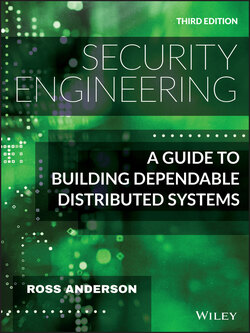Читать книгу Security Engineering - Ross Anderson - Страница 62
2.5.4 Intimate relationship abuse
ОглавлениеJust as I ended the last section by discussing whistleblowers – the insider threat to companies – I'll end this section with intimate relationship abuse, the insider threat to families and individuals. Gamergate may have been a flashbulb example, but protection from former intimate partners and other family members is a real problem that exists at scale – with about half of all marriages ending in divorce, and not all breakups being amicable. Intimate partner abuse has been suffered by 27% of women and 11% of men. Stalking is not of course limited to former partners. Celebrities in particular can be stalked by people they've never met – with occasional tragic outcomes, as in the case of John Lennon. But former partners account for most of it, and law enforcement in most countries have historically been reluctant to do anything effective about them. Technology has made the victims' plight worse.
One subproblem is the publication of non-consensual intimate imagery (NCII), once called ‘revenge porn’ – until California Attorney General Kamala Harris objected that this is cyber-exploitation and a crime. Her message got through to the big service firms who since 2015 have been taking down such material on demand from the victims [1693]. This followed an earlier report in 2012 where Harris documented the increasing use of smartphones, online marketplaces and social media in forcing vulnerable people into unregulated work including prostitution – raising broader questions about how technology can be used to connect with, and assist, crime victims [867].
The problems faced by a woman leaving an abusive and controlling husband are among the hardest in the universe of information security. All the usual advice is the wrong way round: your opponent knows not just your passwords but has such deep contextual knowledge that he can answer all your password recovery questions. There are typically three phases: a physical control phase where the abuser has access to your device and may install malware, or even destroy devices; a high-risk escape phase as you try to find a new home, a job and so on; and a life-apart phase when you might want to shield location, email address and phone numbers to escape harassment, and may have lifelong concerns. It takes seven escape attempts on average to get to life apart, and disconnecting from online services can cause other abuse to escalate. After escape, you may have to restrict childrens' online activities and sever mutual relationships; letting your child post anything can leak the school location and lead to the abuser turning up. You may have to change career as it can be impossible to work as a self-employed professional if you can no longer advertise.
To support such users, responsible designers should think hard about usability during times of high stress and high risk; they should allow users to have multiple accounts; they should design things so that someone reviewing your history should not be able to tell you deleted anything; they should push two-factor authentication, unusual activity notifications, and incognito mode. They should also think about how a survivor can capture evidence for use in divorce and custody cases and possibly in criminal prosecution, while minimising the trauma [1250]. But that's not what we find in real life. Many banks don't really want to know about disputes or financial exploitation within families. A big problem in some countries is stalkerware – apps designed to monitor partners, ex-partners, children or employees. A report from Citizen Lab spells out the poor information security practices of these apps, how they are marketed explicitly to abusive men, and how they break the law in Europe and Canada; as for the USA and Australia, over half of abusers tracked women using stalkerware [1497]. And then there's the Absher app, which enables men in Saudi Arabia to control their women in ways unacceptable in developed countries; its availability in app stores has led to protests against Apple and Google elsewhere in the world, but as of 2020 it's still there.
Intimate abuse is hard for designers and others to deal with as it's entangled with normal human caregiving between partners, between friends and colleagues, between parents and young children, and later between children and elderly parents. Many relationships are largely beneficent but with some abusive aspects, and participants often don't agree on which aspects. The best analysis I know, by Karen Levy and Bruce Schneier, discusses the combination of multiple motivations, copresence which leads to technical vulnerabilities, and power dynamics leading to relational vulnerabilities [1156]. Technology facilitates multiple privacy invasions in relationships, ranging from casual annoyance to serious crime; designers need to be aware that households are not units, devices are not personal, and the purchaser of a device is not the only user. I expect that concerns about intimate abuse will expand in the next few years to concerns about victims of abuse by friends, teachers and parents, and will be made ever more complex by new forms of home and school automation.
